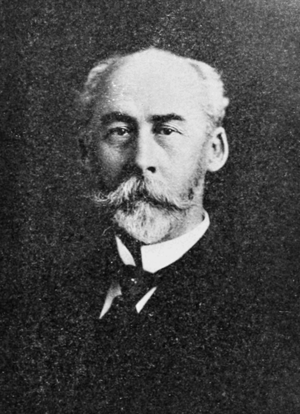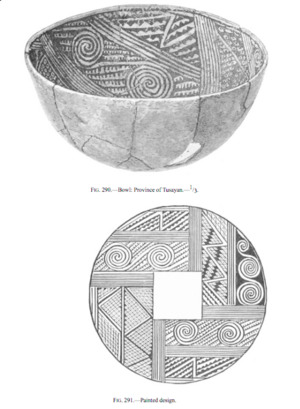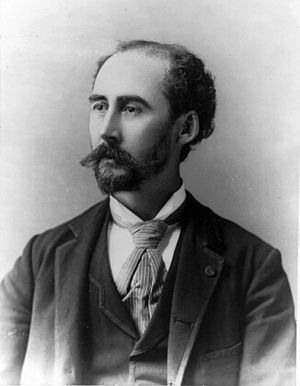William Henry Holmes facts for kids
Quick facts for kids
William Henry Holmes
|
|
|---|---|

Holmes in 1918
|
|
| Born | December 1, 1846 |
| Died | April 20, 1933 (aged 86) |
| Resting place | Rock Creek Cemetery, Washington, D.C. |
| Nationality | American |
| Known for | Scientific Illustration of the American West; Role in Controversy over the Antiquity of Man in the Americas |
| Spouse(s) | Kate Clifton Osgood Holmes (m. 1883) |
| Awards | Loubat Prize (1898, 1923) |
| Scientific career | |
| Fields | Anthropology, Archaeology, Art, Scientific Illustration, Cartography, Curator, Geology |
| Institutions | Smithsonian Institution, Field Museum of Natural History |
William Henry Holmes (born December 1, 1846 – died April 20, 1933), also known as W.H. Holmes, was an amazing American explorer, scientist, and artist. He was an anthropologist (someone who studies human societies and cultures), an archaeologist (someone who studies human history through digging up old things), and a geologist (someone who studies Earth's rocks and history). He was also a talented artist and scientific illustrator, drawing many things for science. Holmes was also a cartographer (map maker) and worked as a museum curator and director.
Contents
A Life of Discovery and Art
Early Life and Learning
William Henry Holmes was born on a farm in Ohio on December 1, 1846. He loved to draw and learn about nature. In 1870, he finished school and briefly taught drawing, painting, and geology. Later, he received special degrees for his important work.
Exploring the American West
The Hayden Survey
In 1871, Holmes went to Washington, D.C., to study art. Scientists at the Smithsonian Institution noticed his talent. Soon, he was hired to draw fossils and shells.
In 1872, Holmes joined a government survey led by Ferdinand Vandeveer Hayden. This was a team exploring the American West. Holmes became an artist and mapmaker. His first trip was to the new Yellowstone National Park.
During the 1870s, Holmes became famous for his scientific drawings and maps. He also became a pioneering archaeologist and geologist. He helped create a detailed map of Colorado.
The Dutton Survey
After the Hayden Survey ended, Holmes traveled to Germany to study art and learn about museums. When he returned, he joined the United States Geological Survey. He worked with Clarence Dutton as a geologist and illustrator.
Holmes created amazing illustrations for Dutton's book about the Grand Canyon. His large drawing of the Grand Canyon from Point Sublime is a famous piece of American scientific art. A mountain in Yellowstone National Park, Mount Holmes, was named after him.
In 1875, Holmes started studying the ancient Ancestral Puebloans in Utah. He made models of their old ruins, which were very popular at an exhibition in Philadelphia. He became very interested in their ancient pottery and shell art. He also studied their textiles (woven fabrics). He became a top expert on the art of Native Americans in the Southwest.
Working at the Smithsonian
In 1889, Holmes joined the Smithsonian Institution as an archaeologist. This is a very important museum and research center. For a few years, he worked at the Field Columbian Museum in Chicago. There, he led an expedition to Mexico.
He returned to the Smithsonian in 1897. He became the head of anthropology at the U.S. National Museum. From 1902 to 1909, he was the director of the Bureau of American Ethnology. During this time, he studied the Etowah Indian Mounds in Georgia. He also published a book about pottery.
In 1910, he became the chairman of the Anthropology Division at the U.S. National Museum. In 1920, Holmes became the director of the National Gallery of Art. He created exhibits of Native American art from the Northwest Coast. He wrote many books about archaeology and anthropology.
Later Years and Art Legacy
William Henry Holmes retired in 1932. He passed away on April 20, 1933. After his death, a special exhibition of his artworks was held at the Corcoran Gallery of Art. He was also a teacher, and one of his students was Susan Brown Chase.
His Important Legacy
Holmes is well-known for his role in a big discussion about how long humans have lived in the Americas. He believed that any claims about very old human settlements needed to be checked very carefully. His careful approach helped make American archaeology more accurate.
Two mountains are named in his honor: Mount Holmes in Yellowstone National Park and Mount Holmes in Utah.
Selected Writings
Here are some of the books and papers William Henry Holmes wrote:
- Pottery of the Ancient Pueblos (1886)
- Archaeological Studies among the Ancient Cities of Mexico (1895)
- Handbook of Aboriginal American Antiquities (1919)
Gallery
-
Panorama from Point Sublime, a famous illustration of the Grand Canyon by Holmes (1882)
-
Mesa Encantada, a watercolor painting by Holmes (1914)
See also
 In Spanish: William Henry Holmes para niños
In Spanish: William Henry Holmes para niños







